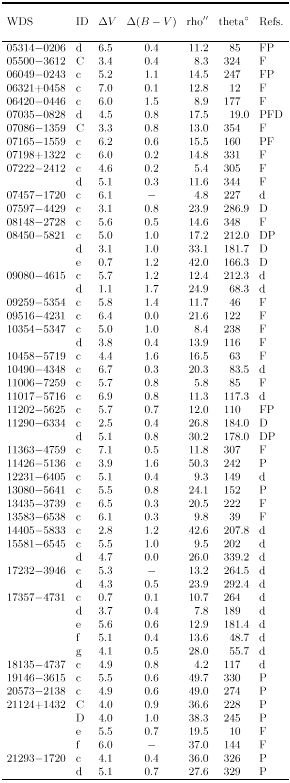On some object frames there were one or several faint stars located close to the
main pair. To make our information on the environment of our doubles
more comprehensive we tried to detect all the stars lying closer than ![]() to the primary. Also some relatively bright stars were
sometimes measured at larger separations. Too faint, tertiary components were
not measured in the ultraviolet.
to the primary. Also some relatively bright stars were
sometimes measured at larger separations. Too faint, tertiary components were
not measured in the ultraviolet.
Some fifty tertiaries were found, with a V -magnitude difference with the
primary up to ![]() . At the level of
. At the level of ![]() the
scope is apparently complete. This detection was followed by an immediate ("on-fly")
estimation of the V - and B -magnitude differences with the primary
component, obviously a rather rough estimate because normally the magnitude
difference is too large: errors are about
the
scope is apparently complete. This detection was followed by an immediate ("on-fly")
estimation of the V - and B -magnitude differences with the primary
component, obviously a rather rough estimate because normally the magnitude
difference is too large: errors are about ![]() in
in ![]() and
and
![]() in
in ![]() . Relative positions of detected stars have an
uncertainty of about 1-2 pixels (
. Relative positions of detected stars have an
uncertainty of about 1-2 pixels (![]() ).
).
The parameters of all surrounding stars are collected in
Table 5. Columns give the WDS identifier, a companion
identifier, differential photometry data ![]() and
and ![]() and position parameters
and position parameters ![]() and
and ![]() relative to the primary. The last
column denotes the reference to the method with which these parameters were
obtained. Original "on-fly" data are signed as "F", while other cases are
described below.
relative to the primary. The last
column denotes the reference to the method with which these parameters were
obtained. Original "on-fly" data are signed as "F", while other cases are
described below.

|
For some "tertiaries" we made an attempt to improve the quality of our data.
The results from full-aperture (![]() ) photometry of
sufficiently distant and not very faint star are presented with a reference
"P". They were obtained by exactly the same technique as the total object
photometry. The astrometry quality remains the same as for "F"-cases,
while errors of V and
) photometry of
sufficiently distant and not very faint star are presented with a reference
"P". They were obtained by exactly the same technique as the total object
photometry. The astrometry quality remains the same as for "F"-cases,
while errors of V and ![]() are less, about
are less, about ![]() and
and
![]() , respectively.
, respectively.
Some multiple stars with up to 5 visual companions were measured
with the help of DAOPHOT. These results are added to
Table 5 with a remark "D" or "d", depending upon the choice of
stars for the point spread function model. The first case corresponds to the
usage of a bright enough and well separated star in the field. The "d"-method
corresponds to the use of
an artificial PSF star with Moffat shape determined from the binary star fit
(see Sect. 2). The estimated precision of the DAOPHOT technique is
![]() in photometry and
in photometry and ![]() in astrometry.
in astrometry.
All the errors of photometry given above correspond to magnitude difference
![]() ; they are about 1.5 times larger for
; they are about 1.5 times larger for ![]() between
between ![]() and
and
![]() and 2 times larger for fainter stars.
and 2 times larger for fainter stars.
To make sure that we have not assigned the wrong identifier to a
previously known tertiary component, we extracted the existing information on
them from WDS (1996). The tertiaries were identified using their ![]() and
and ![]() . WDS gave four identifications of our
tertiaries, their identifiers in Table 5 are given in
upper-case; all the rest are in lower-case letters.
. WDS gave four identifications of our
tertiaries, their identifiers in Table 5 are given in
upper-case; all the rest are in lower-case letters.
Evidently, most stars are field ones. The comparison of their photometric parallaxes to spectroscopic ones of primaries (or to those from Hipparcos when available) is the subject of further study in order to decide about the physicity of some companions to the main pairs A+B. An interesting case is a non-WDS bright and close tertiary companion "c" of WDS 17357-4731 = CP-47 11654. According to its photometry, it has a higher probability to be a physical one than the B-component.
Copyright The European Southern Observatory (ESO)